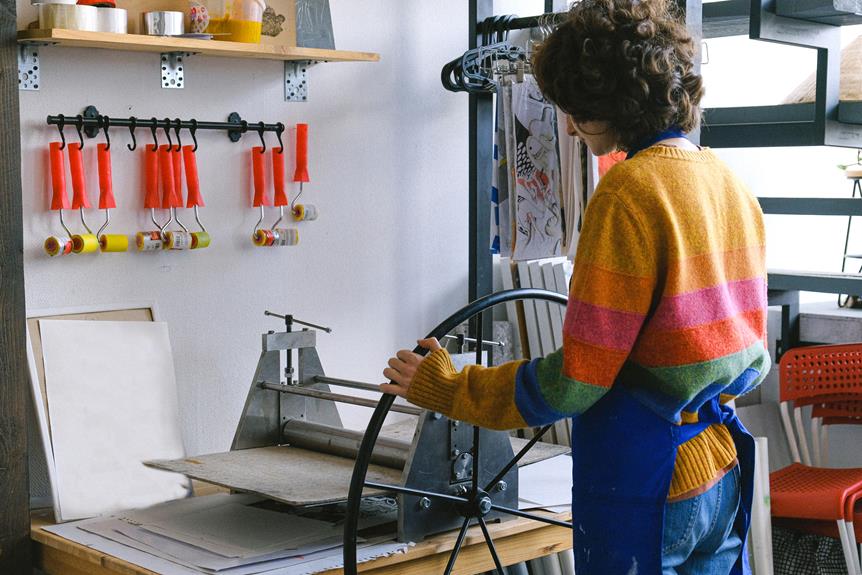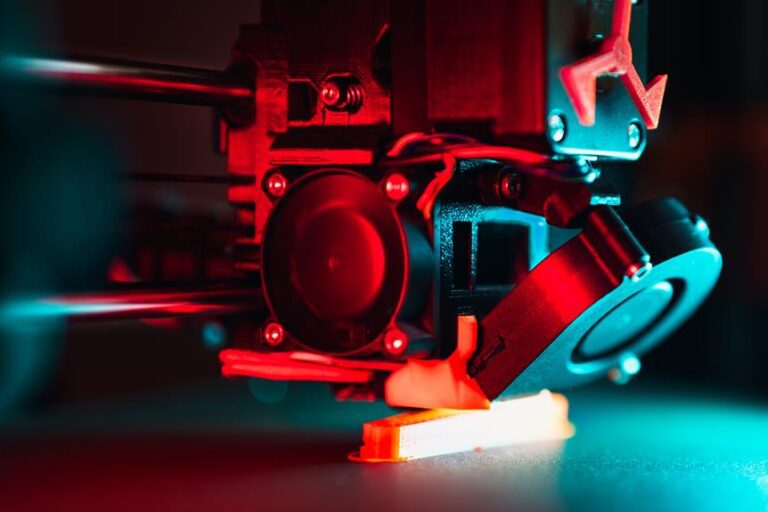Small-Batch Production With 3D Printing: Cost-Effective Manufacturing
In the realm of manufacturing, small-batch production has long been viewed as an elusive and costly endeavor. However, with the advent of 3D printing, a new era of cost-effective manufacturing has emerged.
Like the nimble and resourceful honeybee, this innovative technique allows for the creation of intricate and customized products with unparalleled efficiency.
In this article, we will explore the vast potential of small-batch production with 3D printing, revealing how this technology can liberate businesses from the constraints of traditional manufacturing methods.
Key Takeaways
- Reduction in production costs
- Elimination of expensive tooling and molds
- Greater flexibility and customization
- Quick response to market demands
The Benefits of Small-Batch Production With 3D Printing
Small-batch production with 3D printing offers numerous advantages for manufacturers. With the advent of on-demand 3D printing services and custom 3D printing services, manufacturers can now benefit from cost-effective manufacturing processes that were previously unattainable.
One of the primary benefits of small-batch production with 3D printing is the reduction in production costs. Traditional manufacturing methods often require expensive tooling and molds, which can be prohibitive for small-scale production runs. However, with 3D printing, manufacturers can bypass these costs by directly printing the desired products. This eliminates the need for tooling and molds, resulting in significant cost savings.
Furthermore, small-batch production with 3D printing allows for greater flexibility and customization. Manufacturers can easily modify designs and quickly produce prototypes or small production runs without the need for extensive retooling. This enables manufacturers to respond quickly to market demands and customer preferences, ultimately improving customer satisfaction and increasing sales.
Additionally, 3D printing enables manufacturers to reduce waste and optimize resource utilization. With traditional manufacturing methods, excess materials are often discarded, resulting in significant waste. However, 3D printing only uses the exact amount of material required for each product, minimizing waste and reducing environmental impact.
Cost-Effective Manufacturing Solutions With 3D Printing
When it comes to cost-effective manufacturing solutions, 3D printing offers several advantages.
One of the key benefits is reduced production costs, as it eliminates the need for expensive tooling and molds.
Additionally, 3D printing enables increased manufacturing efficiency by allowing for faster prototyping and iteration cycles.
Moreover, it offers scalability with minimal investment, as small-batch production can be easily adjusted and scaled up or down as needed.
Reduced Production Costs
Utilizing 3D printing technology can offer numerous cost-saving benefits for manufacturers. Here are four ways in which 3D printing can help reduce production costs:
- Elimination of tooling costs: With traditional manufacturing methods, creating molds and tooling can be expensive. 3D printing eliminates the need for these molds, resulting in significant cost savings.
- Reduced material waste: Traditional manufacturing processes often result in significant material waste. 3D printing, on the other hand, only uses the exact amount of material required for the product, minimizing waste and reducing material costs.
- Streamlined supply chain: 3D printing enables manufacturers to produce parts on-demand, eliminating the need to maintain large inventories. This reduces warehousing and inventory costs, leading to overall cost savings.
- Faster time to market: 3D printing allows for rapid prototyping and iteration, enabling manufacturers to bring products to market faster. This reduces development costs and increases competitiveness in the market.
Increased Manufacturing Efficiency
By implementing streamlined processes and adopting 3D printing technology, manufacturers can significantly enhance their manufacturing efficiency and achieve cost-effective production solutions.
The use of 3D printing allows for the creation of complex geometries and intricate designs that were previously difficult or impossible to produce using traditional manufacturing methods. This technology enables manufacturers to optimize their production processes by reducing material waste, eliminating the need for multiple tooling setups, and minimizing the time required for design iterations.
With 3D printing, manufacturers can also consolidate multiple components into a single printed part, reducing assembly time and simplifying supply chains. In addition, the ability to rapidly prototype and iterate designs with 3D printing enables manufacturers to quickly identify and correct any inefficiencies in the production process, resulting in improved overall efficiency and reduced costs.
Scalability With Minimal Investment
Achieving scalability with minimal investment is a key advantage of incorporating 3D printing into cost-effective manufacturing solutions. This technology allows businesses to easily scale production based on demand without incurring significant upfront costs. Here are four ways in which 3D printing enables scalability with minimal investment:
- Reduced tooling costs: Traditional manufacturing methods require expensive molds and tools, which can be a barrier to scaling production. With 3D printing, there is no need for these costly tools, making it easier and more affordable to increase production volume.
- Faster design iterations: 3D printing allows for rapid prototyping and design iterations. This means that manufacturers can quickly test and refine their products before scaling up production, minimizing the risk of costly errors and ensuring a more efficient scaling process.
- On-demand manufacturing: With 3D printing, manufacturers can produce products on-demand, eliminating the need for large inventory and storage space. This not only reduces upfront costs but also enables businesses to respond quickly to changing market demands.
- Customization at scale: 3D printing enables mass customization, allowing manufacturers to produce unique, personalized products at scale. This customization capability can attract a wider customer base and increase market share without significant investment in additional production equipment or processes.
Exploring the Potential of 3D Printing in Small-Batch Production
3D printing offers numerous advantages in small-batch production, allowing for enhanced customization and faster turnaround times. This technology has revolutionized the manufacturing industry by providing a cost-effective solution for producing small quantities of highly tailored products.
One of the key benefits of 3D printing in small-batch production is the ability to create complex geometries and intricate designs that would be difficult or even impossible to manufacture using traditional methods. This level of customization enables businesses to meet the specific needs and preferences of individual customers, leading to increased customer satisfaction and loyalty.
Additionally, 3D printing allows for faster turnaround times compared to traditional manufacturing processes. With 3D printing, there is no need for expensive tooling or lengthy setup times, as the production process can be initiated directly from a digital design file. This eliminates the need for time-consuming and costly retooling when transitioning between different product designs.
Furthermore, 3D printing enables businesses to iterate and refine their designs more quickly. By rapidly prototyping and testing different iterations, companies can identify and address design flaws or improvements in a timely manner. This iterative process can significantly reduce the time and cost associated with traditional design iterations, ultimately accelerating the product development cycle.
Finding Reliable 3D Printing Service Providers for Small-Batch Manufacturing
Finding reliable 3D printing service providers for small-batch manufacturing can be a critical step in ensuring the quality and efficiency of the production process. With the increasing demand for small-batch production, it is important to choose a service provider that can meet the specific requirements of your project.
Here are four factors to consider when selecting a reliable 3D printing service provider:
- Experience and Expertise: Look for a provider with a proven track record in small-batch manufacturing. They should have experience in handling similar projects and possess the necessary expertise to deliver high-quality prints.
- Technology and Equipment: Consider the type of 3D printing technology and equipment used by the service provider. Ensure that they have the latest and most advanced machinery to produce accurate and precise prints.
- Material Options: Check if the service provider offers a wide range of materials suitable for your project. Different materials have different properties and capabilities, so it is important to have options that meet your specific requirements.
- Turnaround Time and Pricing: Evaluate the turnaround time and pricing structure of the service provider. Look for a provider that can deliver within your desired timeframe without compromising on quality. Additionally, compare prices to ensure that the services offered are cost-effective.
Agile Manufacturing With 3D Printing: a Cost-Effective Approach
The implementation of agile manufacturing using 3D printing has proven to be a cost-effective approach in various industries. By leveraging the capabilities of 3D printing technology, companies can achieve greater flexibility, reduced costs, and faster time-to-market for their products.
One of the key benefits of agile manufacturing with 3D printing is the ability to quickly iterate and make design changes on the fly. Traditional manufacturing methods often require expensive tooling and long lead times, making it difficult to make modifications once production has started. With 3D printing, however, companies can easily adjust and refine their designs without incurring significant costs or delays.
Moreover, 3D printing allows for on-demand production, eliminating the need for large inventories and reducing storage costs. Instead of producing large batches of products, companies can print items as needed, reducing waste and the risk of overproduction. This approach also enables customization and personalization, as each item can be tailored to the specific needs and preferences of the customer.
To better understand the cost-effectiveness of agile manufacturing with 3D printing, let's consider a comparison between traditional manufacturing and 3D printing:
| Cost Factors | Traditional Manufacturing | 3D Printing |
|---|---|---|
| Tooling Costs | High | Low |
| Production Costs | High | Low |
| Lead Times | Long | Short |
As shown in the table above, 3D printing offers significant cost advantages over traditional manufacturing methods. The low tooling costs and reduced production costs contribute to overall cost savings. Additionally, the shorter lead times enable companies to bring products to market faster, increasing their competitiveness.
Maximizing Efficiency in Small-Batch Production Through 3D Printing
One can maximize efficiency in small-batch production through the implementation of 3D printing technology. This revolutionary technology offers numerous benefits that enable manufacturers to optimize their production processes and achieve higher levels of efficiency. Here are four ways in which 3D printing can enhance small-batch production efficiency:
- Reduced setup time: Traditional manufacturing methods require extensive setup processes, including creating molds and tools. With 3D printing, manufacturers can directly print the desired objects, eliminating the need for time-consuming setup procedures.
- Faster production cycles: 3D printing allows for rapid prototyping and iteration, enabling manufacturers to quickly test and refine their designs. This accelerated product development cycle translates to shorter production times and faster time-to-market.
- Customization and personalization: Small-batch production often involves producing unique or customized products. 3D printing enables manufacturers to easily customize each item by making slight adjustments to the digital design, eliminating the need for costly and time-consuming reconfiguration of traditional manufacturing processes.
- Reduced material waste: Traditional manufacturing methods often result in significant material waste due to the need for cutting, shaping, and molding. 3D printing, on the other hand, adds material layer by layer, resulting in minimal waste and more efficient use of resources.
Implementing 3D Printing for Cost-Effective Small-Batch Manufacturing
To achieve cost-effective small-batch manufacturing, manufacturers can implement 3D printing technology in their production processes. 3D printing, also known as additive manufacturing, offers numerous advantages over traditional manufacturing methods, making it an ideal solution for small-batch production.
One key benefit of 3D printing is its ability to eliminate the need for expensive tooling and molds. With traditional manufacturing, creating molds and tooling can be costly, especially for small production runs. However, with 3D printing, products can be directly printed from digital designs, bypassing the need for molds and tooling altogether. This not only reduces upfront costs but also minimizes lead times, allowing manufacturers to quickly produce small batches of products in a cost-effective manner.
Additionally, 3D printing enables manufacturers to optimize material usage and reduce waste. Traditional manufacturing often results in significant material wastage due to the need to remove excess material during the production process. In contrast, 3D printing is an additive process, meaning that material is only added where it is needed. This eliminates the need for excess material and reduces waste, resulting in cost savings.
Moreover, 3D printing allows for design flexibility and customization, which can be particularly beneficial for small-batch manufacturing. Manufacturers can easily modify digital designs to meet specific customer requirements, without incurring additional costs associated with retooling or reengineering. This level of customization not only enhances customer satisfaction but also improves overall cost-effectiveness.
Frequently Asked Questions
What Are the Main Advantages of Small-Batch Production With 3D Printing Compared to Traditional Manufacturing Methods?
The main advantages of small-batch production with 3D printing, compared to traditional manufacturing methods, include reduced costs, faster production times, increased customization options, and the ability to rapidly iterate designs.
How Does 3D Printing Contribute to Cost-Effective Manufacturing Solutions for Small-Batch Production?
3D printing contributes to cost-effective manufacturing solutions for small-batch production by reducing the need for expensive tooling and minimizing material waste. It allows for on-demand production, short lead times, and the ability to customize products, resulting in lower production costs and increased efficiency.
What Are Some Potential Applications of 3D Printing in Small-Batch Production?
Potential applications of 3D printing in small-batch production include rapid prototyping, custom manufacturing, on-demand production, and agile manufacturing. These applications offer increased flexibility, reduced lead times, and cost-effective production solutions for niche markets.
How Can Businesses Find Reliable 3D Printing Service Providers for Their Small-Batch Manufacturing Needs?
When it comes to finding reliable 3D printing service providers for small-batch manufacturing needs, businesses should consider factors such as expertise, track record, quality assurance processes, and customer reviews to ensure a cost-effective and efficient production process.
Can You Explain the Concept of Agile Manufacturing With 3D Printing and How It Can Be a Cost-Effective Approach for Small-Batch Production?
Agile manufacturing with 3D printing is a cost-effective approach for small-batch production. It combines the flexibility of agile methodologies with the efficiency of 3D printing, allowing businesses to quickly adapt to market demands and reduce production costs.
Conclusion
In conclusion, small-batch production with 3D printing offers cost-effective manufacturing solutions that can significantly benefit businesses. By exploring the potential of 3D printing in small-batch production and finding reliable service providers, companies can embrace agile manufacturing approaches and maximize efficiency.
Implementing 3D printing for cost-effective small-batch manufacturing enables businesses to reduce costs, increase flexibility, and achieve higher levels of precision. This innovative technology revolutionizes traditional manufacturing processes and opens up new possibilities for businesses to thrive in a competitive market.









